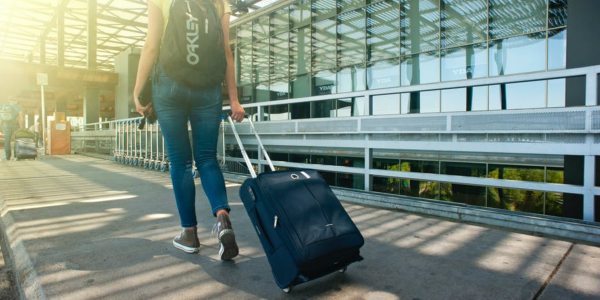Hotel Trends Overview September 2024
U.S. Hotels State of the Union September 2024 Edition
Economy
- An upside surprise in Q2 GDP could lead to a more optimistic outlook for 2024.
Q2 GDP growth of 3.0% exceeded CBRE expectations of 2.0%. CBRE increased expected growth in Q3 and Q4 to 1.3% and 1.1% from 1.1% and 1.0%, respectively. CBRE predicts inflation to remain more persistent and interest rates to be elevated, with the first rate cut expected in September. - Consumer risks remain as wage gains and employment growth slow.
Unemployment ticked up in July to 4.3% from 3.5% a year ago as employment growth slowed to zero. The softening employment market appears to be weighing on consumer sentiment. Despite increases in nominal consumer borrowing, leverage ratios remain below pre-pandemic levels on both a real and nominal basis. - CMBS borrowing rates remained elevated at 7.4% but were off their highs.
CMBS loan issuance increased materially from $0.6 billion in July 2023 to $1.7 billion in July 2024. While the average loan count increased slightly, the average loan size more than doubled from $53.9 million in July 2023 to $118.1 million in July 2024.
Current Trends
- RevPAR fell 0.8% in July on the higher mix of leisure travel.
July RevPAR fell because of a 1.1% decline in occupancy and relatively flat ADR, up only 0.3%. While leisure trends continued to normalize, upscale and upper-upscale chains in favored urban locations outperformed again in July. RevPAR for group and business-focused location types surpassed leisure destinations. - Short-term rentals posted healthy demand growth of 9.5% in July.
In July, short-term rentals continued to take share from hotels, with demand growing to 16.1% of total share compared with 15.0% in July of 2023. STR RevPAR declined 0.9% because of a pullback in ADR coupled with flat occupancy. Revenue for short term rentals was 57% higher than 2019 compared with hotels which were 14% above pre-pandemic levels. - June profits increased 0.9%, above the year-to-date decline of 1.0%.
Total revenue growth of 1.3% was offset by a 110-basis point contraction in GOP margins. Insurance, wages, and property taxes are all increasing more than total revenues, leading to continued pressure on hotel margins.
Food for Thought

- CBRE reduced its 2024 RevPAR growth forecast from 2.0% to 1.2%.
CBRE expects 2024 RevPAR to be bolstered mostly by ADR growth of 1.1%, driven primarily by growth in group, business transient, and international travel. RevPAR growth for urban and airport locations is expected to outperform, while resorts are expected to lag in 2024. - Inbound international travel continued to lag outbound at 86% of 2019.
Outbound international travel ended July at 118% of 2019’s level, while inbound travel remained below 90%, weighing on demand. Travel from Japan and China continues to hover around 50%. Inbound travel trends to both coasts have been steadily recovering. - TSA throughput ended August at 105% of 2019 levels.
TSA throughput increased 5.1% in August below the year-to-date average of 6.1%, but in line with July’s 5.2% growth. Despite continued strength in passenger volumes, Airport RevPAR only increased 0.5% in July.
High-Level Inflation Overview: Pressures Expected on Key Areas Within The Hospitality Industry
- Attempts to cool inflation off historic highs are expected to continue until core indicators return closer to 2%.
- The unemployment rate remains near historic lows, keeping consumer spending solid even in the current inflationary environment.
- Food demand slowed or declined throughout 2023, with the sharpest falls in retail food sales.
- Costs of key raw material inputs, fuel, freight, and ocean shipping have dropped from peak levels as supply, labor, and trade-related stresses eased. Input cost inflation in some industrial sectors is nearing or falling below 0% vs last year.
- Geopolitical risk due to the ongoing conflict in the Middle East and Ukraine remains concerning. A further escalation of the conflicts could have serious implications to high food insecurity. Gold prices, which often indicate global uncertainty, have risen. The rise in natural gas prices due to Russia’s invasion of Ukraine and the corresponding impact on industrial metals remains a challenge.
Asia Pacific Boosts Global Travel Health Index
Achieving 13% growth above July 2023, Asia Pacific is the only region to surpass 2023 performance this month. This surge is largely due to the region’s delayed reopening after the pandemic. While some countries have fully recovered, even surpassing pre-pandemic levels, certain travel patterns, like Chinese outbound travel, are still navigating a rebound. The index shows softening performance across the other regions over last year as they remain 3-5% below July 2023 levels. Asia Pacific is the driving force behind growth this year.
Skift Travel Health Index Score by Region & Top Countries
China leads, with a 21% performance uptick year-on-year. India witnessed the highest month-on-month growth, surging 8 percentage points (pp) above June 2024. Japan, too, is among the countries topping the charts this month. According to the Daily Lodging Report, driven by the weak yen and summer holidays, the country set a record for visitor arrivals for the second month straight. The number of foreign visitors in July this year reached 3.3 million, topping June’s 3.1 million. This pace puts Japan on track to surpass its 2019 record of 31.9 million visitors. China remains the dominant source market, accounting for 1.9 million visitors, almost 85% of 2019 levels.
China’s International Expansion

China is rebounding slowly, but with low consumer confidence and high interest rates, disposable income is tighter, leading to more domestic holidays. While China’s international airline seat capacity has not completely rebounded back to pre-pandemic levels, as of July 2024, it has grown ~56% above last year. However, it is the Chinese Airlines that have been driving growth in seat capacity and frequency to international regions. While the seat capacity and frequency of non-Chinese airlines remain 42% below 2019 levels, Chinese airlines are only 9% and 10% behind, respectively. Chinese airlines have significantly expanded their European operations since Summer 2023. The number of scheduled flights from Chinese airlines to Europe has increased 74%, surpassing Summer 2019 by 16%. This appears to be an attempt by Chinese airlines to break out of current market conditions by capitalizing on the Russian overflight restrictions imposed on competing airlines.
August 2024 U.S. Transportation Sector Unemployment (4.8%) Falls Below the August 2023 Level (4.9%) and Hits Same Level as the Pre-Pandemic August 2019 Level (4.8%)
The unemployment rate in the U.S. transportation sector was 4.8% in August 2024, according to the Bureau of Labor Statistics (BLS). In August 2024, the transportation sector unemployment rate fell 0.1 percentage points from 4.9% in August 2023 and was the same as the pre-pandemic August 2019 level of 4.8%.
Unemployment in the transportation sector was higher than overall unemployment. BLS reports that the U.S. unemployment rate in August 2024 was 4.4% or 0.4 percentage points below the transportation sector rate. Seasonally adjusted, the U.S. unemployment rate in August 2024 was 4.2%.
Transportation Sector and U.S. Total Unemployment Rate, August 2019 – August 2024
Employment in the transportation and warehousing sector rose to 6,624,400 in August 2024—up 0.1% from the previous month and up 1.2% from August 2023. Employment in transportation and warehousing grew 16.3% in August 2024 from the pre-pandemic August 2019 level of 5,695,800.
- Air transportation is up 0.4% from the previous month and up 4.0% from August 2023.
- Truck transportation is down 0.1% from the previous month but remained unchanged from August 2023.
- Transit and ground passenger transportation rose to 441,700 in August 2024—up 1.0% from the previous month and up 2.4% from August 2023.
- Rail transportation remained virtually unchanged in August 2024 to the previous month but down 1.2% from August 2023.
- Water transportation is down 1.7% from the previous month but up 3.9% from August 2023.
- Pipeline transportation is down 2.4% from the previous month but up 2.7% from August 2023.
- Warehousing and storage are up 0.2% from the previous month but down 0.3% from August 2023.
American Travelers’ Maintain a Steady Financial Outlook Fueling a Strong Travel Sentiment Heading into Fall
- The financial outlook among American travelers has held steady year-to-date, with the share of those who said that their household is better off compared to a year ago at 31.8 percent this month (down just 1.1 points from last month). Though American travelers’ financial sentiment in 2024 has not yet registered peaks seen in Fall 2023 (34.8%), this August tracks well above the 27.3 percent recorded for this metric the same time last year, at +4.5 percentage points higher than August 2023. In general, American travelers overall continue to maintain a stable financial outlook, with a steady sense of current financial well-being and a positive outlook.
- This month, 35.1 percent of Americans agreed that now is a good or very good time to spend on travel, a slight gain (+1.3 points) over last month, and well above the same metric for August 2023 (25.5%, a +9.6 percentage point increase). Similarly, there have been minimal shifts in how American travelers are prioritizing travel as a budget priority in the near term. But perhaps the biggest indicator that Americans are serious about spending on travel in the near term is this month’s data around maximum leisure travel spending expected in the next 12 months. Americans who stay in luxury hotels report looking at how this shakes out by generation. This high budget is led by Baby Boomer travelers ($6,459) despite their more tepid financial sentiment and outlook. Notably, the maximum expected leisure travel spend in the next 12 months is above $4,000 across all generations.
Closing out a Colossal Summer Travel Season and Sustaining Travel Volume into the Future
- Americans traveled at great rates in Summer 2024: 8 percent took 1.0 overnight leisure trips on average in June, 50.9 percent took 1.1 overnight leisure trips in July and 47.7 percent took 0.9 overnight leisure trips in August—the highest levels recorded in the last 2 years.
- Americans’ excitement for travel remains near record levels at 8.2 on a 0-10 scale—the same as it was one year ago. Another indicator that travel sentiment is in good health: 2024 metrics on the share of Americans who have done online travel research within the last week have consistently outperformed both 2022 and 2023.
- Looking ahead, 9 percent of American travelers say they have trips planned in September; fully 33.2 percent have trip plans for October. The number of anticipated leisure trips in the next 12 months also continues to hold steady, with American travelers reporting an average of 3.6 leisure trips expected in the next year, with 89.6 percent saying they will travel for leisure at least once.
- Travel volume mirrors the stability we are seeing around financial outlook and travel spending sentiment. While budgets are up, there has not been a noticeable increase in expectations for more travel in the near term, suggesting that American travelers may spend more on the same amount of trips rather than necessarily increasing their overall number of trips.
Destination Considerations, Trip Planning Windows, and Other Notable Travel Planning Behaviors
- Safety concerns around crime and violence are the top-most important consideration in destination selection—far outpacing expense, health risk, extreme weather, societal issues, and politics, and spanning across all generations. When it comes to social issues and/or a destination’s politics or policies, it’s Millennial-age travelers who are most likely to take these into consideration (41.5% and 33.3%, respectively).
- Trip planning windows have lengthened in 2024 relative to 2023, when they were at a 3-year low. Right now, American travelers report they would begin planning a week-long vacation 11.5, a week longer than one year ago. Interestingly for travel marketers, nearly one-third said they always (8.5%) or often (23.7%) adjust their travel dates or destinations to take advantage of better deals or lower costs.
Sources
-
- CBRE: September 2024 Edition
- SOTI: 2024 State of the Industry
- Skift Report: Report for July
- Bureau Of Transportation: August 2024 U.S. Transportation Sector
- Future Partners: The State of the American Traveler in September 2024



